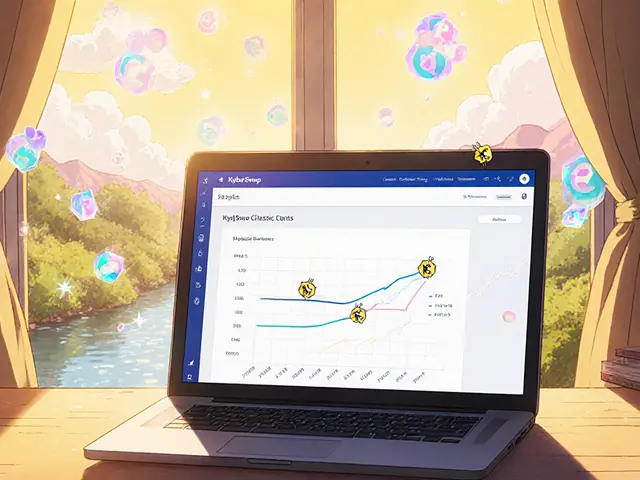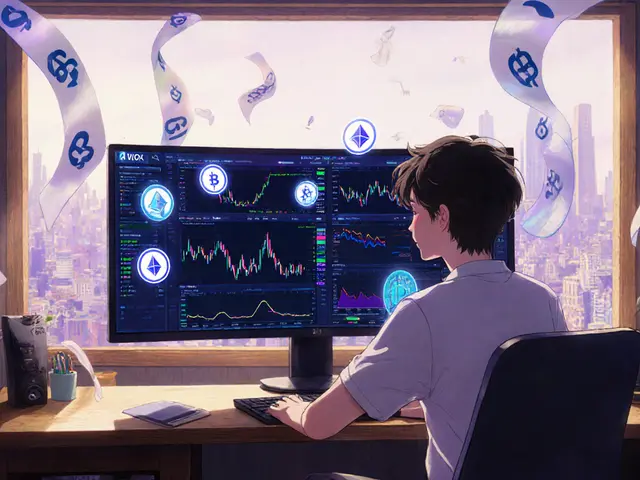22
Sushiswap on Arbitrum Nova: A Realistic Review of Trading Risks and Rewards

Sushiswap (Arbitrum Nova) Slippage Calculator
This tool calculates expected trading costs on Sushiswap (Arbitrum Nova) based on real data showing daily trading volume under $5,000 for most pairs. Use it to understand the impact of slippage on your trades.
Your estimated trading costs will appear here after calculation.
Sushiswap (Arbitrum Nova) is a decentralized exchange built on Arbitrum Nova, a layer-2 scaling solution for Ethereum that reduces transaction costs and increases speed. It's part of the broader Sushiswap protocol, which began as a Uniswap fork in 2020. As of October 2023, Sushiswap Arbitrum Nova recorded less than $5,000 in daily trading volume across all pairs-making it one of the least liquid decentralized exchanges in the entire DeFi space.
What is Sushiswap on Arbitrum Nova?
Sushiswap (Arbitrum Nova) is a specific implementation of the Sushiswap protocol running on Arbitrum Nova. Unlike the main Sushiswap version that supports over 30 blockchains, this version is limited to Arbitrum Nova's network. It uses an Automated Market Maker (AMM) model where trades happen directly between users and liquidity pools instead of a central order book. The platform was launched in 2022 to leverage Arbitrum Nova's low gas fees, but it's far from the liquid trading hub its creators hoped for.
Key Features and Real-World Performance
Here's what Sushiswap (Arbitrum Nova) actually delivers:
- Ultra-low fees: Average swap costs are just $0.003 per transaction, compared to $1.50-$5 on Ethereum mainnet. This makes it ideal for micro-transactions.
- Extremely limited liquidity: The top trading pair (MOON/WETH) has a 24-hour volume of $67.51 according to CoinCodex, while CoinGecko reports $22,359.59 for MOON/0X722...-showing inconsistent data across sources. Most pairs trade under $5,000 daily.
- Only 6 tokens available: Including WETH, USDC, MOON, and three others. No major altcoins like SOL or DOT are listed.
- High price slippage: With thin liquidity, even small trades can move prices by 5-10% due to low market depth.
Comparison with Other Arbitrum Nova DEXs
| Exchange | CoinGecko Volume (Oct 15) | CoinCodex Volume (Oct 17) | Market Share | Tokens Available |
|---|---|---|---|---|
| Sushiswap (Arbitrum Nova) | $22,359.59 (MOON/0X722...) | $70.18 | 88.1% | 6 |
| RCP Swap | N/A | N/A | 6.8% | 4 |
| Sushiswap V3 (Arbitrum Nova) | N/A | $15.42 | 5.1% | 3 |
Despite claiming 88.1% market share on Arbitrum Nova, Sushiswap (Arbitrum Nova) still only controls a tiny slice of the global crypto market. Arbitrum Nova's entire DEX ecosystem accounts for 0.0% of the $34.2 billion daily global crypto trading volume reported by CryptoCompare in October 2023.

Pros and Cons
- Pros
- Near-zero transaction fees ($0.003 per swap)
- Simple interface for basic token swaps
- Part of Sushiswap's ecosystem with xSUSHI rewards for liquidity providers
- Cons
- Extreme liquidity shortages-most pairs have under $5,000 daily volume
- Only 6 tokens available for trading
- High slippage on trades over $100
- Conflicting volume data across tracking platforms
- Withdrawal delays due to Arbitrum's 7-day fraud proof window
Who Should Use This Exchange?
If you're trading small amounts under $100 and need to save on gas fees, Sushiswap (Arbitrum Nova) might work for you. For example, swapping $50 worth of MOON tokens costs less than a penny in fees. It's also useful for testing new tokens with minimal risk since large trades won't drain the pool. However, this is only for users who understand the risks of thin liquidity and don't need immediate access to funds due to withdrawal delays.
Who Should Avoid It?
Avoid Sushiswap (Arbitrum Nova) if you're trading more than $200 at once, need to trade less common tokens, or require fast withdrawals. With only 6 tokens available, you can't build a diversified portfolio. The platform also lacks margin trading and advanced order types, making it useless for professional traders. Most importantly, the inconsistent volume data suggests unreliable liquidity-something you can't afford when moving significant capital.

Security Risks and Withdrawal Delays
Arbitrum Nova uses optimistic rollup technology, which means transactions take 7 days to finalize. This creates withdrawal delays that could be dangerous in volatile markets. For instance, if you need to sell during a crash, you'd wait a week for funds to clear. Additionally, the thin liquidity makes the platform vulnerable to price manipulation. A single large trade could wipe out a liquidity pool, causing massive losses for other users. According to ICO Rankings' October 2023 review, "thin liquidity across trading pairs makes it unsuitable for substantial trades without significant price impact."
Better Alternatives for Low-Fee Trading
For serious traders, better options exist:
- Sushiswap on Polygon has over $200 million daily volume and 1,000+ trading pairs
- Uniswap on Ethereum mainnet offers deep liquidity despite higher fees ($1.50-$5 per trade)
- PancakeSwap on BSC has $100 million daily volume with fees under $0.50
These platforms provide reliable liquidity and faster withdrawals while still keeping costs manageable. As Delphi Digital noted in their October 5, 2023 report, "DEXs with less than $10,000 daily volume face existential challenges due to insufficient liquidity mining rewards to attract serious liquidity providers."
Frequently Asked Questions
Is Sushiswap on Arbitrum Nova safe to use?
The platform uses audited smart contracts verified on Arbiscan, but safety depends on your use case. For small trades under $100, it's relatively safe. However, the thin liquidity creates risks of price manipulation and slippage. Always start with tiny amounts to test the platform before committing more capital.
How do I connect my wallet to Sushiswap on Arbitrum Nova?
You'll need to configure MetaMask with Arbitrum Nova's RPC settings: Network Name: Arbitrum Nova, RPC URL: https://nova.arbitrum.io/rpc, Chain ID: 42170. Once added, visit Sushiswap's website and connect your wallet. If you're new to layer-2 networks, this process can be confusing-consider using a simpler platform like PancakeSwap first.
What's the minimum trade size I can make?
You can swap as little as $1 worth of tokens, but be aware that fees are fixed at $0.003 regardless of trade size. For tiny trades, this fee becomes a significant percentage of your transaction. For example, swapping $1 costs 0.3% in fees, while swapping $100 costs just 0.003%. Always calculate fees before making small trades.
Are there better alternatives for low-fee trading?
Yes. Sushiswap on Polygon offers similar low fees ($0.01-$0.05 per trade) with 100x more liquidity and 1,000+ tokens. PancakeSwap on BSC has fees under $0.50 and $100 million daily volume. Both platforms support larger trades without slippage issues and have better user reviews.
Why is the trading volume so inconsistent across different sources?
Decentralized exchanges often have data discrepancies because tracking services like CoinGecko and CoinCodex pull data from different sources. Some report total volume across all pairs, while others focus on specific token pairs. For example, CoinGecko reported $22,359.59 for MOON/0X722... on October 15, 2023, while CoinCodex listed Sushiswap V3 with just $15.42 on October 17. This inconsistency highlights how unreliable the platform's liquidity metrics are.










Jenna Em
October 22, 2025 AT 02:11The thin liquidity feels like a silent trap waiting for the unwary.
Stephen Rees
October 22, 2025 AT 03:35When you glance at the volume numbers, you realize the platform is more of a curiosity than a competitor. The near‑zero fees are attractive, but they mask the deeper issue of price impact. A trader moving $100 can shift the price by double digits, which is hardly acceptable for anyone seeking stability. Moreover, the seven‑day withdrawal window adds a layer of risk that most users overlook. In the grand scheme, this DEX feels like a side‑project rather than a serious marketplace.
Katheline Coleman
October 22, 2025 AT 04:58Dear readers, the data presented underscores a stark reality for low‑volume DEXes. While the transaction fees are commendably low, the paucity of liquidity imposes severe constraints on trade execution. Users attempting trades above modest amounts may encounter slippage that erodes any fee advantage. Additionally, the seven‑day finality period on Arbitrum Nova could expose participants to market volatility. It is advisable for newcomers to allocate only a fraction of their capital to such environments. Diversifying across more established layers, such as Polygon or BSC, can mitigate these risks. Ultimately, the platform serves a niche purpose rather than a universal solution. Thank you for your attention.
Amy Kember
October 22, 2025 AT 06:21Low fees are great
Liquidity is basically non‑existent
Slippage kills small trades
Avoid large moves altogether
Evan Holmes
October 22, 2025 AT 07:45The UI looks okay, but the numbers say otherwise. I’d skip this DEX unless you’re just playing around.
Isabelle Filion
October 22, 2025 AT 09:08Ah, the allure of “ultra‑low fees” – a siren song for the faint‑hearted. One would think that such a selling point would attract hordes of traders, yet the daily volume whispers a different tale. With merely six tokens listed, the platform resembles a boutique shop rather than a bustling marketplace. The reported 88.1% market share on Nova is a statistical illusion born of an almost empty field. High slippage further deters any ambition beyond micro‑transactions. Withdrawal delays, courtesy of the optimistic rollup, add a bureaucratic touch reminiscent of legacy banking. In short, Sushiswap on Nova is a curiosity better left on the sidelines.
Ryan Comers
October 22, 2025 AT 10:31Wow, another “low‑fee” DEX that nobody uses 😂. Let’s not pretend it’s going to replace Uniswap any time soon 🚀.
Prerna Sahrawat
October 22, 2025 AT 11:55The architecture of Arbitrum Nova, while ostensibly a marvel of scalability, masks a confluence of systemic deficiencies that render Sushiswap’s presence on it almost perfunctory. First, the token roster is constrained to six entries, a limitation that stifles any semblance of portfolio diversification. Second, the daily trading volume, oscillating between a few thousand dollars, is insufficient to generate meaningful price discovery. Third, the high slippage percentages, often breaching five percent on modest trades, betray the fragility of the liquidity pools. Fourth, the seven‑day withdrawal latency introduced by the optimistic rollup paradigm imposes an unnecessary exposure to market turbulence. Fifth, the inconsistent reporting between CoinGecko and CoinCodex fuels distrust among data‑savvy participants. Moreover, the platform’s reward mechanisms, such as xSUSHI incentives, are unlikely to lure substantial liquidity providers given the meager fee accruals. In aggregate, these facets coalesce into a narrative where the DEX functions more as a testbed for low‑fee experimentation than a viable trading venue. Prospective users should therefore calibrate expectations and allocate only token amounts they are prepared to lose without regret.
Joy Garcia
October 22, 2025 AT 13:18Swirling through the ether of Nova, you stumble upon a DEX that whispers promises of negligible fees yet shouts volatility. The trading pairs are as sparse as desert oases, leaving wanderers thirsty for depth. Slippage erupts like fireworks the moment you nudge the pool, rendering micro‑trades a gamble. Withdrawal delays stretch into a week, a temporal chasm that can swallow fortunes in a market tumble. If you crave speedy exits, better chart a course elsewhere. For the daring few, this may be a playground for experimenting with token alchemy.
mike ballard
October 22, 2025 AT 14:41From a protocol perspective, the AMM model on Nova suffers from suboptimal liquidity provisioning, leading to adverse price impact metrics. The gas‑optimised execution layer reduces overhead, but the net effect is negligible given the shallow order books. Users should monitor the impermanent loss vectors, especially when deploying capital into nascent pools. Integration with Layer‑Zero bridges could alleviate cross‑chain frictions, albeit at additional complexity. Overall, the stack presents a classic trade‑off scenario. 😎
Molly van der Schee
October 22, 2025 AT 16:05Hey everyone, just wanted to point out that if you’re only swapping tiny amounts, the fee savings can actually add up over time. It’s still wise to test with $1‑$5 swaps first to see how the slippage behaves. Keep an eye on the withdrawal window so you don’t get caught off guard if the market shifts. Diversify your exposure by also using more liquid DEXes for bigger moves. Stay safe and happy trading!
Mike Cristobal
October 22, 2025 AT 17:28Honestly, if you’re serious about crypto you shouldn’t waste time on a platform with under $5k volume. The risk‑reward ratio is stacked against you. Stick to the heavy hitters where depth is guaranteed. 🚀💎
Erik Shear
October 22, 2025 AT 18:51Low fees are nice
Liquidity is a joke
Don’t expect big trades to work
Tom Glynn
October 22, 2025 AT 20:15Think of this DEX as a training ground-perfect for honing your swaps without burning cash on gas. Start with micro‑trades, observe the price impact, and progressively scale up only when you’re comfortable. Remember, the seven‑day finality is a patience exercise; use it to plan your moves ahead. The ecosystem may be small now, but your experience will serve you across any platform. Keep learning and the returns will follow! 🌱🚀
Johanna Hegewald
October 22, 2025 AT 21:38The fees are almost nothing.
Benjamin Debrick
October 22, 2025 AT 23:01Indeed, the ultra‑low fee structure is a commendable engineering achievement; however, the glaring deficit in liquidity cannot be ignored; this deficiency precipitates severe slippage, which in turn nullifies the fee advantage; consequently, prudent traders might find the platform unsuitable for substantial positions; a thorough risk assessment is essential before committing capital.
Anna Kammerer
October 23, 2025 AT 00:25Oh great, another “solution” that solves nothing. Pay near‑zero gas only to watch your trade get vaporized by slippage. If you enjoy watching numbers disappear, feel free to dive in.
Mike GLENN
October 23, 2025 AT 01:48The data presented in the review paints a vivid picture of a DEX struggling to find its footing in a competitive landscape. While the ultra‑low transaction fee of $0.003 is undeniably attractive, it is merely a veneer that obscures deeper systemic flaws. The limited token selection, capped at six, restricts users from constructing diversified positions without hopping across multiple platforms. Daily trading volume hovering below $5,000 indicates a paucity of active participants, which in turn depresses market depth. High slippage rates, often exceeding five percent on trades as modest as $100, erode any nominal fee savings. The seven‑day withdrawal delay imposed by the optimistic rollup architecture introduces a temporal risk that cannot be ignored. In volatile market conditions, this delay could mean the difference between a timely exit and a substantial loss. Moreover, the inconsistent reporting between analytics providers like CoinGecko and CoinCodex fuels uncertainty about the true health of the liquidity pools. Liquidity providers receive xSUSHI rewards, yet the modest fee generation may not be sufficient to entice substantial capital inflows. Traders seeking to execute larger orders will inevitably encounter price impact that outweighs the cost benefits touted by the platform. For developers, the smart contracts have been audited, but the real‑world usage data suggests limited adoption. Comparatively, alternative DEXes on Polygon and BSC boast orders of magnitude higher volume and token variety, providing a more robust trading experience. Users must therefore weigh the trade‑off between cheap micro‑transactions and the safety net of deep liquidity. In practice, the platform may serve as a sandbox for experimental token swaps rather than a primary venue for serious trading. Ultimately, prudent participants should allocate only a small, disposable portion of their portfolio to this environment, reserving the bulk of their capital for more liquid and reliable exchanges.
BRIAN NDUNG'U
October 23, 2025 AT 03:11It is essential to recognize that transaction costs, while minimal, do not singularly dictate a platform’s suitability. The broader ecosystem, including liquidity depth and withdrawal latency, plays a pivotal role in trade execution quality. Users who prioritize cost efficiency above all else may find a niche here, yet they must remain vigilant to slippage risks. Integrating a diversified strategy across multiple L2 solutions can mitigate exposure. In conclusion, careful assessment will determine the appropriate allocation of assets.
Donnie Bolena
October 23, 2025 AT 04:35Low fees are great, but beware of the slippage; the liquidity is thin, which can erode gains; always test with small amounts before committing larger sums; patience is key, especially with the week‑long withdrawal period.
Elizabeth Chatwood
October 23, 2025 AT 05:58i think its a good place for tiny swaps but dont use it for big moves its to risky
Tom Grimes
October 23, 2025 AT 07:21The platform looks cool but the risk is high if you move more than a little.
Paul Barnes
October 23, 2025 AT 08:45Liquidity metrics are unreliable; trust the data before diving.
John Lee
October 23, 2025 AT 10:08Imagine a bustling marketplace where every stall is empty; that’s how Sushiswap on Nova feels-glittering fees with a hollow crowd. The occasional trade is like a fireworks display that fades instantly. For those who love the thrill of the hunt, it might amuse for a moment, but the lack of depth leaves you yearning for more. Trading here is a dance on a tightrope over a canyon of volatility. In short, it’s a novelty, not a mainstage.
Jireh Edemeka
October 23, 2025 AT 11:31Ah, the promise of “ultra‑low fees” – a classic case of style over substance. When the order books are practically barren, the only thing you’re really paying for is the privilege of watching your token’s price swing wildly. If you enjoy living on the edge, sure, dive in; otherwise, there are better ways to spend your time.